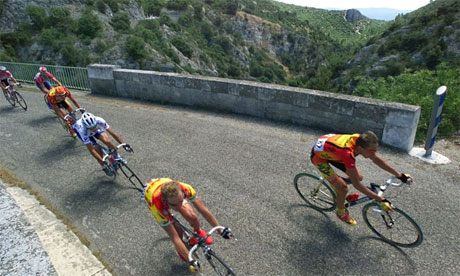
As you read this column, I hope I will be out on the trail of the royal eagle in the French Pyrenees. My family are devotees of house-swapping and this year we are staying halfway up a mountain, not far from Pau, which Tour de France aficionados will know as the start of the muscle-crunching 10th stage.
In fitness terms, this is not good news.
Nature never intended me to be one of cycling's mountain climbers, and it's safe to say that I will not be attempting the "hors category" Col du Tourmalet, with its average gradient of 7.5%.
Any illusions I might have had about my mountain-biking ability were crushed by a pilgrimage a few years back to Tour cyclist Tom Simpson's shrine on Provence's Mont Ventoux: it's an extraordinary experience, which I would recommend to any holidaymaker, not least for the revelation that the top of the mont is so ventoux that it's virtually impossible even to stand up when you get out of your car, let alone stay on a bike.
Hard-core readers may scoff that this anecdote doesn't actually involve much cycling, but there's a value in being a backseat biker: it's not until you actually go to places such as Mont Ventoux that you can appreciate just how different pro cyclists are from the rest of the human race.
It is a lesson the Bike Fixer General has been reluctant to accept. He still has fantasies about doing Tour de France stages (indeed, he's gone so far as to practise on the hills outside Hay-on-Wye). Watching the pain on the faces of the Tour riders during this year's mountain stages made me so apprehensive that I had to cheer myself up by getting out the holiday snaps from a stay in the Italian alps. There we all are, smiling cheesily by our bikes, at the top of a very manageable glacier (though we had to drive to Switzerland to find it).
You may by now be wondering where royal eagles fit into the picture, but birds and bikes are natural holiday companions. You can creep up on them so much more easily on two wheels; you can chase them cross country without even noticing the burn, and if you set out having researched the species that are particular to an area, they give you a reason to get off your sun lounger for at least a couple of hours of exercise every day.
I'm as amateur a twitcher as I am a cyclist, but - like cycling - it's a hobby that can be enjoyed at any level or location. Even if you are stuck at home with the kids in the middle of the city, you can make your own bird-spotting trail.
The key tip is to head for the nearest waterway - canals are just as good as rivers, and even in the centre of most cities you are rarely far away from one. They have the great virtue of being more-or-less flat and studded with pubs, which is a boon if you've just torn your kids kicking and screaming from the Xbox and everyone's in a bit of a grump.
Even if you can't find a waterway within biking distance, there is no need to despair. My three-mile route across London to work involves daily contact with a colony of what I recently learned from the great birder Mark Cocker to be rooks (if they were crows, they wouldn't go around in a gang).
It also enabled me to be among the first to spot that green parakeets had moved into my local park - their tinny screeching instantly transformed the soundscape of the neighbourhood - in a way that no motorist would have noticed.
Until that moment, I don't think I was really aware of how much the average, unplugged-in cyclist hears on an ordinary journey. It is yet another reason, surely, to get on your bike this summer.

